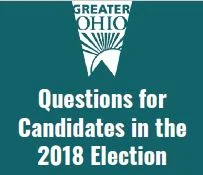We would appreciate your feedback by Friday, August 14, 2020.
Registration Now Open for 2019 GOPC Summit
GOPC Releases Candidate Questions as a Resource to Ohio's Next Governor, Policymakers
The non-partisan Greater Ohio Policy Center (GOPC) released its “Questions for Candidates in the 2018 Election.” This document challenges the next governor, other statewide office-seekers, and legislative candidates to articulate their policy positions on a range of quality-of-life and redevelopment issues.
Brachman Presents Ways to Leverage the Economic Potential of Ohio's Cities, Towns & Metros
By Samantha Dawson, GOPC Intern Last Thursday, January 22, GOPC’s Executive Director, Lavea Brachman presented at OSU’s Center for Urban & Regional Analysis. During the presentation, “Shining Cities on a Hill or Lights Under a Bushel? Realizing the Economic Potential of Ohio’s Cities, Towns and Metros,” Lavea discussed ways for regenerating prosperity in Ohio’s cities, towns and metros and leveraging the state’s assets to fulfill our cities’ potential.
Research on city trajectories has indicated little population growth and subsequent decreases in economic standing in our legacy cities. By looking at other locations that have successfully revitalized, such as Pittsburgh and Baltimore, Greater Ohio has been learning ways to improve these cities’ potential.
In order to return prosperity to these cities, a positive transformation needs to take place--introducing these metropolises to the new economy. By physically rebuilding these areas and introducing new uses to vacant properties, there will be growth and regeneration of the success these communities have previously experienced. The introduction or connection of economic engines, such as universities and hospitals, is also vital to the growth of these cities, as well as the exploration of other potential engines capable of retaining people and businesses. Thinking regionally is also a main goal in restoring these areas.
It is apparent that policies need to include a more intentional urban agenda for the restoration of Ohio’s cities as the economic engines of the state. Encouraging the cities to work interdependently is a challenging, yet hopeful prospect for Ohio.
GOPC Invites Panel Proposals for its June 2015 Summit on Innovation & Sustainable Growth in Ohio
 Deadline for Letters of Interest: November 14, 2014
Deadline for Letters of Interest: November 14, 2014
Restoring Neighborhoods, Strengthening Economies: A Summit on Innovation and Sustainable Growth in Ohio's Cities & Regions, a Summit hosted by the Greater Ohio Policy Center on June 9-10 of 2015 at the Westin Columbus, will explore the links between neighborhood revitalization and regional growth that make economically Ohio competitive in the 21st century.
GOPC welcomes champions of sustainable development from across Ohio to participate in this Summit, creating a dialogue around both policy and practice that will set an agenda for innovation, sustainable growth, and economic prosperity in Ohio.
We invite Letters of Interest describing panels that address the role of innovation and sustainable development in city and regional revitalization and economic growth in Ohio, such as:
- approaches to generating and supporting innovation economies in Ohio’s cities
- strategies for metropolitan and regional sustainable development and economic growth
- practices for vacant and abandoned property reuse and community revitalization
- financial tools for infrastructure improvement
- options and financing for advancing multimodal transportation
- financial tools and partners for strengthening neighborhoods and downtowns
- case studies of ways to address environmental and equitable development issues
- innovative governance tools that advance sustainable development and economic growth
- new cross-sector community and regional solutions for revitalization
Summit sessions will address a wide range of topics essential to sustainable development and economic growth in Ohio, appealing to an audience that includes civic, business, philanthropic, non-profit and political leaders, including bankers, developers, and practitioners. The Summit will highlight cutting-edge strategies and practices, new tools, effective partnerships and policy solutions that are laying the foundation for building sustainable, prosperous, innovative communities and regions in Ohio and beyond.
Format and Process for Letters of Interest
Letters of Interest (up to 500 words) should describe the panel concept and how it will contribute to the Summit. Please include a list of proposed speakers and be prepared to confirm their participation upon panel acceptance.
GOPC will work with selected participants to finalize panel topics and speakers. GOPC will notify all individuals who submit a Letter of Interest with a decision by January 2015.
Contact
Please direct any questions about the Summit or this process to gopcsummit@gmail.com. Letters of Interest should be submitted to the same address by November 14, 2014.
About Greater Ohio Policy Center
Greater Ohio Policy Center (GOPC), a non-profit, non-partisan organization based in Columbus and operating statewide, develops and advances policies and practices that value our urban cores and metropolitan regions as economic drivers and preserve Ohio’s open space and farmland. Through education, research, and outreach, GOPC strives to create a political and policy climate receptive to new economic and governmental structures that advance sustainable development and economic growth.
Lessons of a GOPC Intern
A farewell blog post by Raquel Jones, a fantastic GOPC Intern
As a lifetime resident of the capital of Ohio, I have come to learn and appreciate the unique experiences and amenities offered through Ohio’s cities. Over the years, I have witnessed the many transformations that Columbus and many other cities in the state have gone through as they have fought to create new identities while retaining their historic presence.
Although I was young when it first hit, the Great Recession had a severe impact on my neighborhood and the community that I lived in, as it did in many parts of the state. I remember noticing a rise in foreclosures in the houses surrounding mine. Looking around the core of central Ohio’s metropolitan area, I could see the harsher effects of the downturn in the economy in the high number of boarded-up homes. I found this to be extremely disheartening, as I knew that many of these homes had the potential to be beautiful and once again serve a useful purpose, if only they were given the chance.
When I enrolled in the John Glenn High School Internship program through OSU, I knew that I wanted to work with a nonprofit that was working hard in the community to make a difference. When I was given the chance to intern at the Greater Ohio Policy Center, I knew little about land banks and government-sponsored programs, such as Moving Ohio Forward and the Neighborhood Initiative Program. I am now happy to report that I am knowledgeable in both programs, as well as others. Working at the GOPC has not only taught me about the daily functions of an office, but has also informed me on the process of policy formation, and the role that nonprofits play in engaging and interacting with local, regional, and statewide governments in producing outcomes that are favorable to both parties, as well as the constituents to which these policies affect. I have also become educated in a number of nationwide movements including the call for a multi-modal city, a more sustainably secure system of infrastructure, and public spaces that transcend the mundane.
As I noted earlier, I have learned a great deal about the issues surrounding blighted and vacant properties, and the role that city and county land banks perform in revitalizing distressed neighborhoods. Many localities have implemented programs that demolish or remodel affected properties, so that either the land or building may be given a second-life. This may mean that the land is transformed into a community garden or a side-lot for a neighboring property, or redeveloped for some other purpose. Overall, I have learned from my experiences at GOPC the necessities for creating an economically viable and environmentally tenable community for all those involved.
I believe that it is organizations such as Greater Ohio, with the support and leadership of governmental officials and community members that are responsible for the positive changes taking place in the state. I am confident in the work currently being done, and I am happy to have gotten the chance to work alongside GOPC’s staff in their ongoing push for a brighter future for Ohio.
Raquel Jones was a summer intern for GOPC and she has moved to D.C. to attend George Washington University.
Unique place making: How Ohio should approach the revitalization of its vacant properties
Written by Ryan Dittoe, previous GOPC Intern
Defining a place is a necessary component for recognition and navigation. But unique characteristics that infiltrate an environment lead to an overarching identity of that space, and unique spaces promote cities with substance and life. As an Ohio State University City and Regional Planning student, I am heavily influenced by the idea of making cities look unlike any other. This can begin with small pockets of creative urban development that together construct whole cities with exclusive personalities. Realizing setbacks, color schemes, historical value, transportation modes, walkability, permeability, and other living aspects of a place and how these functions work together ensure its continual success.
Ohio’s vacant properties require attention to detail. Recently I visited Detroit and listened to a presentation given by Detroit Works. They explained the value of creating revitalized, useful areas through public participatory design (that is, encouraging citizens to share ideas about what they would like to see in any given area that is the focus of revitalization or redesign), implementing a framework of ideas for progress to be initiated, and thinking beyond the normal scope of city planning for a unique design that breathes individuality into a space. An example of this plan in action is the open-air art Heidelberg Project, located near southeast Detroit. A public artist transformed this neglected area into a block-wide sculpture site encouraging residents to visit and experience their city through a different perspective. Projects like this one can provide a multitude of starter ideas for neighboring cities, including Columbus, to uniquely develop their invaluable public spaces. Keep in mind that it is crucial not to “copy” another city’s projects, but to strive for uncommon attributes.
Every city needs attractive “third places.” These are locations you visit outside home and work to interact with your family, friends, or colleagues in a more relaxed manner. Incorporating these design pockets into the city offers a functional location for socialization. Ohio’s vacant lots (especially those right here in Columbus) might serve well as third places for existing residential and commercial infrastructure. Creating mixed use buildings with permeable human scale faces will attract patrons that are already visiting the area. Creating safe sidewalks, complete streets, attractive storefronts, public seating with lights, landscaping and other vital aspects of a lively city block will engage passersby and stimulate a city’s reputation. Bring back vitality to blighted spaces and allow their energy to be recreated into something useful and noteworthy. Realize that problems are just an opportunity for improvement and prosperity.





